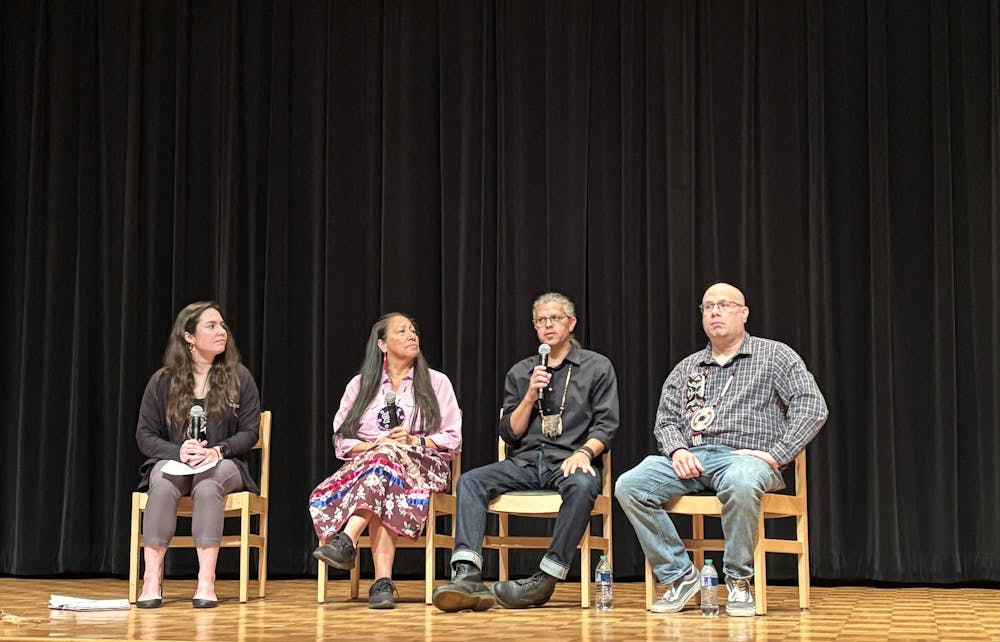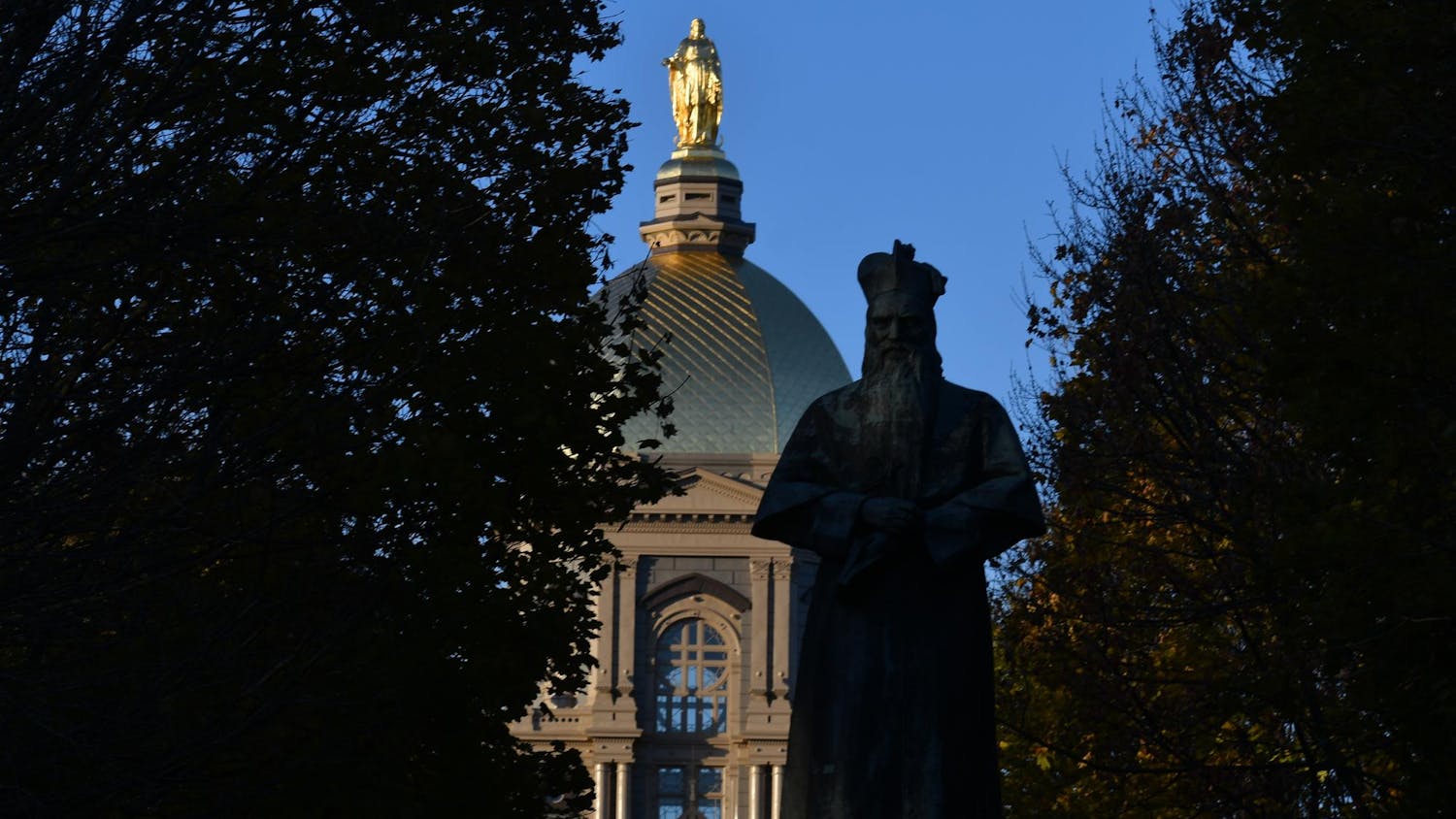The Raclin Murphy Museum of Art, in association with the Terra Foundation for American Art, hosted a two-day Indigenous art symposium titled “Indigenizing Museums” last Thursday and Friday.
The museum held artist demonstrations on Thursday and three symposium sessions on Friday, each inviting Indigenous artists and curators to comment on the decolonization of art and museums as well as efforts to celebrate Indigenous voices, stories and artwork.
Artists David Martin, Christine Rapp-Morseau and Jason Wesaw spoke in the second Friday session titled “Reasserting Potawatomi Presence in Michiana through Art.” As members of the Pokagon Band of Potawatomi, the three artists shared their journeys as artists and discussed how their indigenous culture continues to shape their artwork.
David Martin
Martin served as the 2023-2024 Notre Dame artist-in-residence for the Initiative on Race and Resilience and currently holds a leadership position on the Indigenous Consultation Committee at the Raclin Murphy Museum of Art and the board of directors for the South Bend Museum of Art. His artistry ranges from tattooing to oil painting and stems from his love of dancing and drumming.
Martin also shared his struggles with witnessing discrimination against Native Americans in his tattoo practice and how he addressed his clients when they asked for artwork such as “Indian princess tattoos with the big headdresses.”
“It’s just like the mascots. It’s a presenting of something that’s what they think we look like, a misrepresentation, and it’s carrying on an image of what we are not,” Martin said. “And most of those people, they probably really don’t even care. They just want a cool tattoo.”
About halfway through his tattoo career, Martin opened his own studio, Bicycle Tattoo, and began freely expressing himself as Indigenous. It was around this time Martin decided he was “doing a huge disservice” by continuing to ink people with discriminatory tattoos. Instead of preaching to or refusing his clients, however, Martin began educating and encouraging them to get a tattoo of something “real.”
“If they were dead set that they wanted, like a pin-up, or a Native princess, you know, I pull up pictures from powwows and say, ‘Well, this is actually what we look like. It might not be as fancy as you think it is, but this is real. And wouldn’t you rather have a real one?’” Martin said.
With the success he found in his tattoo education, Martin began to rekindle his love for oil painting, which led to his work on a series of paintings that will recreate artist George Winter’s sketches of the Potawatomi from the 1830s and 1840s.
“Each one is going to be about 12 feet by six feet, and the one that I was originally working [on] here at Notre Dame is going to be the final piece for the whole series. It's going to be a reinterpretation of the original sketch, but how we are now because we've survived,” Martin said. “Here he was documenting all these things that it was like the end … but [dancing was] the thing that brought us back, and it made us stronger.”
Christine Rapp-Morseau
Rapp-Morseau spoke next about her contributions to basket-making, a long-standing tradition within the Potawatomi. Placing baskets of various sizes all over the stage, she explained the process of making splints, the thin strips of black ash trees in order to weave the basket.
“You find the best [black ash] tree that you can find that’s nice and straight, and you cut it down. Then, you have to have the process of pounding all the growth rings off of that log, which is really strenuous. You’re taking the back of an ax, a little thin part, and you’re hitting every couple of inches down that log, because then eventually growth rings will pop up … Then you just pull them, and then you start cutting them where they’re still attached,” Rapp-Morseau said.
She told the audience the story of how her great-grandparents, grandparents, aunts and uncles were among the first to start the “basket co-op” in the town hall when she was a little girl. According to Rapp-Morseau, fond memories of her family and community come to mind when she thinks of how she began basket weaving.
Toward the end of the session, Rapp-Morseau explained she is no longer able to continue making baskets due to a lack of black ash trees, which are endangered by the Japanese beetles that eat through the trunks. The endangerment of the black ash trees also threatens basket weaving as a tradition as the Potawatomi community slowly runs out of splints.
“There are some systems put in place to try and save some trees, but that’s going to take a long time. It’s going to take a long time before we can even harvest those, not I or even my grandkids, probably, but they’re there. As for me, making any more baskets, I’ve kind of stopped because I’m just using what I have,” she said.
Jason Wesaw
Wesaw, whose artwork ranges widely in mixed media, spoke about how he utilizes his work to decolonize exhibitions in museums and uses his voice for his community.
“There was a time when these institutions, and this time was not very long ago, when institutions weren’t interested in working with us or acknowledging us. They were collecting us and harvesting us,” Wesaw said. “And so, through our artwork and through being able to use our voices, we get to expand that narrative that work continues by trying to bring our ancestors home, and all those objects that tell stories from our communities.”
Wesaw explained his artwork as his way of simultaneously connecting with nature around him and the community he is a part of.
“I try to tell a lot about the culture and community that I come from, but I also really try and encourage people to engage with the land … The land doesn’t really like to speak to you in a way that your ears can hear, but your spirit and your body and your heart, can understand that language of the land,” Wesaw said.
After showing the audience various pieces of his work, from pottery and ceramic plates to blankets and tapestries, Wesaw again emphasized his effort in using his artwork to bring communities together.
“I want to create places where people can consider their place amongst the earth and amongst all of creation, to be proud of their culture, but also to be open and accepting of other people’s cultures, other people’s points of view, other people’s politics, other people’s spirituality and religion. There’s room for all of it. Otherwise, ktthe mnedo [Great Spirit] wouldn’t have made things differently,” Wesaw said.










